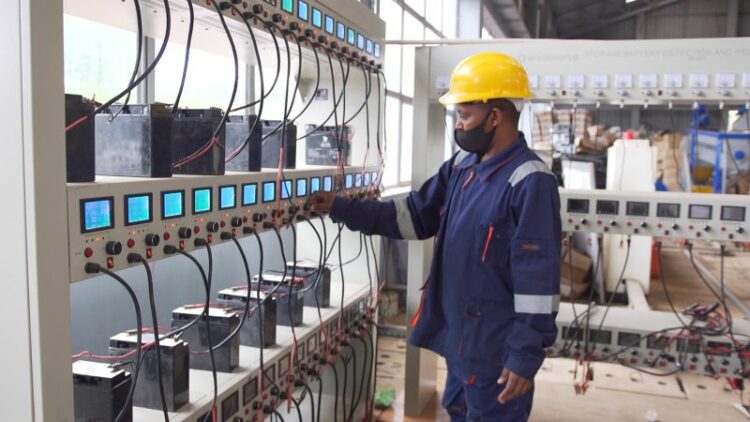CNN
—
For Eric Nshimiyimanain, who owns two small electronic repair shops in Kigali, Rwanda, the startup chime of an old Windows laptop is the sound of a business opportunity.
He refurbishes broken PCs, laptops, phones and secondhand gadgets classified as electronic waste, or “e-waste” that would otherwise end up as trash in Nduba, Rwanda’s only open-air dump in the outskirts of the capital.
“Sometimes we even use computer screens as TVs,” Nshimiyimanain says. Converting those screens to televisions then becomes a cheaper option, he adds, for “citizens who have low incomes and cannot afford buying a brand-new TV.”
In this age of scrambling for the newest high-tech phone, tablet or television, refurbishing broken and outdated gadgets might seem impractical. But for many countries, it’s an important link in the value chain of e-waste management.
According to the UN-affiliated Global E-Waste Monitor report, nearly 54 million metric tons of e-waste was generated around the world in 2019. It includes everything from phones and computer monitors to larger appliances like refrigerators and old fax machines. Together, it weighs “more than all the commercial airliners ever made,” according to the UN.
Rwanda is one of only 13 countries in Africa that have passed national legislation regarding e-waste regulation, according to the report. And it has led to the first official recycling and refurbishing facility in the country.
Operational since early last year, this public-private partnership between the government and Dubai-based Enviroserve became a source of pride for Rwanda. The state-of-the-art plant near Kigali can process up to 10,000 metric tons of e-waste per year.
Rwanda’s focus on local action
According to managing director Olivier Mbera, Enviroserve has already repaired and refurbished more than 5,000 computers, which were sold to public schools. To date, it has processed more than 4,000 tons of e-waste and created more than 600 jobs.
“We’ve also mitigated more than 2,000 tons (of carbon), equivalent to emissions from all the equipment we have recycled,” he says.
Conveyor belts sort plastics from metals, while plexiglass chambers collect phosphor fumes from old tube TVs. Circuit boards pile up in bags and lithium batteries are constantly being tested. Every piece of e-waste is meticulously collected, compacted or crushed.
The hazardous materials are separated from the valuable ones for two reasons, Mbera says. “There are approximately €55 million ($66 million) of resources in (Rwanda’s) e-waste, and if they are not recovered, they’re affecting our economy. Also, there are a lot of hazardous materials that can contaminate the environment.”
Even before lockdowns boosted sales of IT equipment to supply people working from home, the Global E-Waste Monitor report projected nearly 75 million metric tons of electronic equipment will be discarded worldwide each year by 2030. Yet less than 10 million metric tons of e-waste was recycled in 2019.
The report also estimated as much as 20% of all e-waste gets exported – some of which is arriving on the African continent.
In Nigeria, a 2017 study found that the country had annually imported between 60,000 and 70,000 metric tons of secondhand electric and electronic equipment (EEE) – mostly from developed countries such as Belgium, the UK and Germany – but that 19% of those devices were inoperable.
From soot to gold: Finding opportunity among hardship in Africa’s largest e-waste site
And in Ghana, a 2011 Basel Convention report found the country imports roughly 150,000 tons of EEE per year. Its biggest dumping site is Agbogbloshie, which has attracted international attention for its sheer volume of e-waste intake. Described by the Global E-Waste Monitor as a “well-organized scrapyard,” there are more than 5,000 informal scrap workers extracting metals from burning the scraps every day.
Perhaps the biggest opportunity for sub-Saharan nations lies in extracting those valuable raw materials and metals. According to the UN, as much as 7% of the world’s gold is in e-waste.
“Globally, waste is not only increasing in quantity, but also in its complexity and composition,” says Okechukwu Daniel Ogbonnaya, country representative for Rwanda at the Global Green Growth Institute, an intergovernmental organization for sustainable economic growth. “Within an electronic device, there’s gold, silver, platinum … and these sorts of elements could be extracted, providing new business opportunities for small businesses and even for municipalities in regard to generating revenue.”
“Rwanda (is) one of our earliest pioneer members and they’ve done really well when it comes to its transition to a green growth pathway,” he adds.
Mbera points to Enviroserve’s success in Rwanda as a potential spark for an e-waste movement, formal training and job creation across East Africa. “We’re negotiating and talking with different governments in Africa to also establish similar facilities in their countries,” he says.
One thing is certain: it will take all sectors to combat the growing e-waste crisis, whether on a large scale like Rwanda’s Enviroserve or from a local business like Nshimiyimanain’s repair shop.
“The world is tech-driven and everything we need is through the use of technology,” Nshimiyimanain says. “When equipment invented by someone else gets spoiled and I’m able to repair these gadgets, it makes me very happy.”
Source link : https://www.cnn.com/2021/02/26/africa/marketplace-africa-ewaste-electronics-recycle-rwanda-spc-intl/index.html
Author :
Publish date : 2021-02-26 08:00:00
Copyright for syndicated content belongs to the linked Source.
